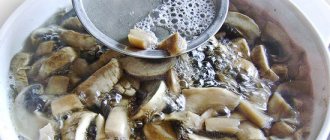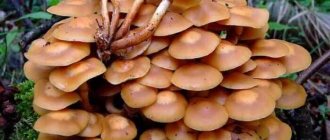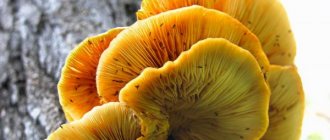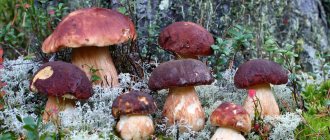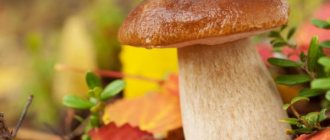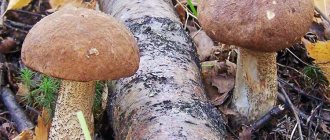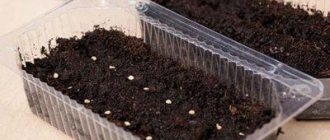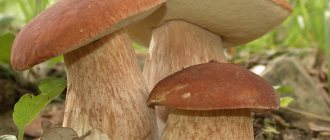Edible and poisonous mushrooms growing on trees
It is not so rare for mushroom pickers to come across mushrooms that grow on trees and stumps. However, as a rule, they do not pay attention to them, because they consider them inedible or simply do not want to get involved with unfamiliar specimens. Indeed, there are quite a few edible ones among them,
and even less tasty and satisfying. However, it would be useful to learn more about them. This is what we propose to do after reading this article. In it you will find photos and names of mushrooms on a tree, and at the same time the answer to the question: are they edible or not.
What mushrooms grow in meadows
When picking mushrooms, do not bypass meadows and clearings. On them you can find delicious tall umbrella mushroom and blushing umbrella mushroom. They are edible, but only the unopened caps are eaten. Champignons collected at a young age are no less tasty.
Among the green grass, here and there, bright red or bright yellow orange lanterns flash, mushrooms with a waxy conical cap, this is hygrocybe. Touch the red cap of Hygrocybe blackens and it will instantly turn black. These mushrooms are beautiful, but they are not eaten, and some species are even poisonous.
You will also see mushroom dances: a larger circle, a smaller circle. They stand tightly one to one, straightening thin flesh-colored caps on an elastic, hard leg. These are edible meadow mushrooms (the caps are edible) belonging to the genus Marasmius. The mushrooms got their name because they dry out during the dry season and come to life after the rains, straightening their wrinkled caps.
It used to be believed that mushrooms grew in places where witches and gnomes danced in circles. The grass in these areas is bad, enchanted, and livestock, after eating it, will certainly get sick. Everything is explained by the fact that the mycelium grows radially, and fruiting bodies are formed on the periphery. If we take into account that the average annual growth of the mycelium is 10 -12 cm, then by measuring the radius, we can approximately calculate the age of the witch's circle. In forests, such circles are rare, since the mycelium encounters obstacles on its way and grows unevenly.
Is it possible to eat?
As we wrote above, among the mushrooms growing on trees and stumps, there are those that can be eaten. Although it should be noted that there are much fewer of them than among those that grow in the soil. The most famous among the mushrooms found on trunks are honey mushrooms. This is the popular name for a group of edible mushrooms that belong to various morphological groups. The mushroom was named so - honey fungus, because most often it grows on living or dead wood, on stumps.
How not to make a mistake in choosing?
Among the mushrooms on wood, there are not only honey mushrooms, but also polypores, oyster mushrooms, scales, and liverworts. They are edible, poisonous and medicinal. Let's get to know them better.
Edible
Not all of the mushrooms listed below are tasty and nutritious, however, they do not cause harm to health. Some of them are well known and popular among experienced mushroom pickers. Here is a list of edible mushrooms growing on trees, with photos and descriptions:
- Oyster mushroom (Pleurotus cornucopiae) . It has a cap in the shape of a horn or funnel. It is light, slightly gray in color. It has a diameter of 3-12 cm. The leg of the oyster mushroom is located in the center, strewn with descending plates, 2-6 cm long. The pulp of the oyster mushroom is white, fleshy, elastic. The mushroom has a slightly pronounced, almost imperceptible aroma and taste. Inhabits deciduous crops from May to September.
- Grifola frondosa . It also has other names: ram mushroom, dancing mushroom. The specimen is easily recognized by its pseudocap joint and light-colored stem. Its flesh is white and fibrous. It has a pleasant taste and aroma. Fruits from June to October. Most common at the base of oak and maple trees. Can have a mass of up to 10 kg.
Poisonous
Among the fungi that parasitize trees, there are, of course, more inedible ones and even those that can cause serious harm to the human body. Here is a list of the most common inedible mushrooms growing on trees, with photos and descriptions:
- Southern Ganoderma (Ganoderma australe) . The cap of this specimen is flat and very large – up to 40 cm in diameter and up to 13 cm in thickness. It has brownish, gray, brown shades. Almost no legs. The pulp of the fruiting body is soft, brown or reddish in color. Likes to settle on poplars, oaks and lindens.
Medicinal
Some mushrooms, growing together with a tree, form fruiting bodies that have medicinal properties. Traditional healers use them to make medicines. These, for example, include mushrooms growing on trees, the photos and names of which you can find below.
- Larch sponge (Fomitopsis officinalis). Its other name is agaricus. The fruiting bodies of the fungus resemble hooves and can also be oblong-cylindrical. They reach a weight of up to 10 kg. Color: white, grayish-white, pale yellow. They grow on conifers, most often on larch. Mushroom-based products weaken, stop bleeding, act as a sedative, and have a mild hypnotic effect. Also used to reduce sweating.
- Lacquered tinder fungus (Ganoderma lucidum). Better known as reishi or lingzhi mushroom. It has an ovoid or kidney-shaped cap with smooth shiny skin of various colors: red, brown, purple, black. The pulp is ocher, tasteless and odorless. It mainly grows on the wood of dead deciduous trees, most often on stumps. Mushroom-based products have antitumor and immune-modulating effects. Used to improve blood circulation, metabolism, and normalize blood pressure.
- Tinder fungus (Inonotus obliquus) , also known as chaga or birch mushroom. The fruiting body grows in diameter from 5 to 40 cm. It has the shape of an irregularly shaped growth. It comes in black. Covered with many small cracks. It usually lives on birch trees, but can also infect alder, maple, rowan, and elm. Products based on beveled tinder fungus are used for antitumor and antigastritis purposes. They have antimicrobial, antispasmodic, diuretic effects.
Inedible mushrooms
The inedible category includes mushrooms that are unsuitable for consumption. They contain hazardous substances that have a toxic effect on the human body. Inedible mushrooms can be poisonous. Eating them poses a serious health hazard.
Thin pig
Thin pig The
thin pig has a slightly convex and fleshy cap, the diameter of which usually does not exceed 13-16 cm. With age, it becomes funnel-shaped, with curled edges. The color of the mushroom is brown-olive or ocher-reddish.
The leg of a thin pig is cylindrical in shape, dense, narrowed at the bottom. Its height is 7-8 cm. The mushroom has soft and loose flesh with a yellowish tint.
Interesting: Why do boletus turn blue?
Svinushka most often grows near oaks, pines, birches, and also in thickets of bushes. It ripens from July to mid-October.
Bile mushroom
Bile mushroom
The gall mushroom has a sharp, bitter taste and a convex cap up to 9-11 cm in size. As the fruiting body ages, it becomes flat-convex, dry and smooth. Most often it has a dark brown or brown color.
Mushroom stalk up to 7-9 cm high, milky-ochre with a brown mesh pattern. The pulp is juicy, white, with a slight pink tint when cut. The gall fungus is considered rare and is occasionally found in coniferous forests from early August to October.
Interesting fact : heat treatment only intensifies the unpleasant, bitter taste of the gall fungus.
Psilocybe semilanceolate
Psilocybe semilanceolate
Psilocybe semilanceolate is a lamellar mushroom with poisonous properties. Most often, the diameter of the cap does not exceed 2-2.5 cm; its shape can be conical or semicircular. The predominant color is cream, milky, with a slight olive tint.
Psilocybe semilanceolata is most often found in meadows and clearings with wet grass. The fruiting period lasts from August to January.
Fly agaric red
Red fly agaric
is one of the most famous and widespread poisonous mushrooms growing in mixed, deciduous and coniferous plantings. Their fruiting lasts from early July to November.
The fly agaric cap is bright red or orange-scarlet in color with whitish dots on the surface. With age, such inclusions may disappear. The leg is cylindrical, up to 18-20 cm high.
Interesting fact : the panther fly agaric is considered one of the most poisonous in the world. One mushroom is enough to poison 3-4 adults.
Death cap
Pallid grebe
The cap of the pale grebe is oval or round in shape, becoming more convex as it ages. Its diameter varies from 5 to 17 cm. The shade can be creamy brown or olive green, sometimes with white spots.
The leg of the pale grebe reaches 6-19 cm in height, depending on climatic conditions. Most often it is narrowed at the top and widened at the base. The fruiting period of the mushroom lasts from late June to mid-October.
Interesting fact : no heat treatment reduces the amount of toxic substances in the pale grebe.
Paneolus moth
Paneolus moth
Paneolus moth is distinguished by its small cap size, not exceeding 1-3 cm. It has a conical shape, which becomes bell-shaped as the mushroom ages. Its surface is covered with scaly white particles. The most common color is brown-olive or beige-gray.
Paneolus moth bears fruit from April to October. Most often it is found in pastures, meadows and grass thickets.
Yellow-skinned champignon
Yellow-skinned champignon
Yellow-skinned champignon can be distinguished by its cap with a yellowish skin and a brownish-brown patch in the central part. In young specimens it has a round shape and reaches 13-17 cm in diameter; with aging, the cap becomes bell-shaped.
The stem of the mushroom is hollow, white, up to 7-16 cm high. Yellow-skinned champignon actively grows after rains - it can be found in forests, parks, squares and gardens, in grassy meadows. The fruiting period lasts from July to the end of October.
Talker brown-yellow
Brown-yellow talker
The cap size of the white-yellow talker reaches 4-7 cm, very rarely it can reach 9-11 cm. It has a convex shape, which becomes more curved over time. The color can be different - milky yellowish, cream, ocher-brown. As the mushroom ages, its color fades. The leg is short, no more than 4-5 cm high, cylindrical in shape.
Interesting: Poisonous mushrooms - list, photo, name, description, video, how to distinguish
Brown-yellow talker grows in mixed and coniferous plantings and forests, bears fruit from the first days of July to the end of October.
Russula Meira
Russula Meira
Russula Meira has dense white pulp with a reddish layer under the skin. The cap is hemispherical in shape with a diameter of up to 3-10 cm; as it ages, it becomes flatter or depressed.
The leg is dense, cylindrical in shape. Most often it is painted white-cream, and may have brownish-brown inclusions at the base. Ripens from late spring until the first frost, grows in deciduous plantings.
Sulfur head
Sulfur head
Sulfur head ripens at the end of August, its fruiting period lasts until the first half of December. Most often, brimstone grows in tall grass in meadows, on stumps and fallen trees.
The mushroom cap is cone-shaped and usually does not exceed 3-6 cm in diameter. As it matures, it becomes flatter, its edges curl upward. The color of the cap in warm and dry weather is creamy yellow, in humid and rainy weather it is brownish-chestnut.
Stropharia blue-green
Blue-green stropharia
The favorite place for blue-green stropharia to grow is fallen coniferous trees, pine and spruce stumps. It can be seen much less often in deciduous and mixed trees. The fruiting period lasts from July to early October.
The mushroom cap has a diameter of up to 4-9 cm and is blue-green in color with ocher spots. The leg is high, up to 11-13 cm, with a slippery surface. The flesh also has a blue or greenish tint.
Fat pig
Thick pig
The fat pig has a large cap up to 10-20 cm in size, most often brown-olive or dark brown in color. In young mushrooms it has a velvety surface, but as it ages it begins to crack and become dry.
The mushroom stem is fleshy, large and thick. Its height reaches 10 cm, the surface is also velvety. Fruiting of the fat pig begins in July and lasts until the end of October. The mushroom is rare; most often it can be found in coniferous forests.
Grille red
The red Reshetochniki
is included in the Red Book of Russia as the only representative of the Reshetochnikov group. The mushroom has an ovoid or spherical fruiting body, the size of which is usually 7-10 cm.
The upper layer of the fruiting body is lattice-like, most often reddish in color, much less often yellow or milky white. The red trellis has no leg. Grows in deciduous forests. Fruits from June to the end of October.
Gymnopil Juno
Gymnopil Juno
Gymnopil Juno has a large and fleshy cap of a yellowish-red or orange hue, the size of which can reach 12-16 cm. Its surface is abundantly covered with numerous scales, the color of which is identical to the color of the cap.
The mushroom stem has a root-like shape and a fibrous structure. Most often it has a thickening at the base. Gymnopil Juno can be seen in oak forests and mixed forests; the mushroom bears fruit from July to the second half of November.
Using stumps to grow mushrooms
The stumps can be used to grow oyster mushrooms. This is easy to do, for example, at a summer cottage. To do this, you will need a shady area or room and several stumps from deciduous trees (birch, aspen, apple, pear, acacia, poplar). Coniferous crops are not suitable for these purposes.
The stumps should not be old, ideally if they are freshly cut. Dry ones will need to be soaked in water for several days. Their sizes do not make a fundamental difference. Convenient sections with a diameter of 15 to 40 cm and a height of 40 to 50 cm.
Oyster mushrooms can be grown both in open areas and indoors. If you plan to place stumps outside, the place should be in the shade and well ventilated. At temperatures below +20°C, agrofibre cover will be required. The optimal time for planting is April-May and August-September. The mycelium germinates within three months.
There are several ways to stack logs. In each of them you will need to dig a ditch at least 30 cm deep and wide, corresponding to the diameter of the wooden blanks. If you have supports for the logs, you don’t have to dig the ground, but place the stumps on its surface.
There are also several ways to introduce mycelium into a stump - for example, by drilling holes, by sawing off the top part, by building a pyramid of logs with several layers of mycelium, etc.
In winter, the stumps will need to be brought indoors or covered with straw or agrofibre.
It is most convenient to lay the logs horizontally, on top of each other, after seeding them with mycelium in the basement or barn. On top they are covered with burlap or perforated film.
When installing logs vertically, they are made into columns and covered with straw and sawdust. The sides of the columns are covered with film or burlap.
The air in the room should be constantly humid. Frequent ventilation is mandatory.
In May, the stumps can be transplanted into the ground in the open air.
TOP 5 interesting facts about tree mushrooms
Edible species that parasitize plants are used in the preparation of salads and main dishes. They are pickled and salted, eaten stewed and fried, and added to snacks and delicacies in Korean and Chinese. Heat treatment is required before use. Energy value (calorie content) – 14-25 kcal.
Interesting facts worth noting:
- Crafts made from wood mushroom. From the hard pulp of some species they make figurines, jewelry (pendants, pendants), and make original lamps and lighting fixtures.
- Ability to bear fruit on wet sawdust, straw or cellulose. This feature allows you to grow some varieties in summer cottages.
- Increases with soaking. Tree mushrooms are small in size when dried, but when placed in water they expand several times in size.
- Taste of seafood. Species growing on trees differ in taste characteristics from classic mushrooms.
- Unique chemical composition. Many species have healing properties for the body and improve mental activity. They are used as part of low-calorie diets for weight loss, in the treatment of allergies, gastritis, oncology, diabetes and other diseases.
Useful types can be purchased in pharmacies in dry form. They are also included in a number of preparations for internal use and external application. In stores they are sold in pressed form (packaging briquettes).
Important! The benefits and harms of tree mushrooms depend on the correct method of preparation and compliance with contraindications. Store them dried in a cool, dry place to prevent the formation of mold.
The effect of fungi on tree bark
Fungi have a destructive effect on trees. It concerns both the bark and its roots. Typically, fruiting bodies are formed on old, diseased, damaged, insect-infested trunks. They can affect both forest plants and fruit crops. They often provoke the development of various rots and other diseases. As a result, the tree may die completely.
But some of the tree fungi, such as tinder fungi, are called forest health workers, since they contribute to the decomposition of old and diseased wood and enrich the soil with nutrients.
Mushroom pickers, while conducting a “silent hunt,” most often look intently at their feet, looking for the desired prey among the grass. However, some of the fungi prefer to grow on tree trunks and roots. And among such mushrooms you can find quite tasty and aromatic specimens, suitable for preparing various dishes. If you don’t have a forest overflowing with mushrooms nearby, then you can grow them for yourself using recently cut down stumps.
Types of tree mushrooms
Mushroom hunters pay attention to apparently unusual species found in the forest on the trunks of rotten or diseased trees and dead wood. In mid-summer and autumn, you can find adult specimens of the most interesting mushrooms, a description of which is presented below.
Askokorine meat
It got its name because the fruiting body resembles pieces of meat of pink-violet shades with plates no more than a centimeter, united over one saucer. Most often found on birch stumps. Does not have a pronounced aroma. The unsightly appearance scares off mushroom gourmets, so its taste is unknown.
Bjerkandera
Belongs to the tinder family and is distinguished by tape-like growth within one year. A mature mushroom of dark brown color resembles a braid of caps, no larger than 3 cm in size. The pulp is fragile, gray in color, and odorless. A thin spore-bearing layer with a clear boundary separates the body of the mushroom from the brown oily cap, as if always wet and grayish at the ends.
Spreads on dead wood and dead wood. It tastes like regular tinder fungus.
Oyster mushroom
Oyster mushrooms quickly burst into our lives, greatly facilitating the preparation of many dishes with rare species of tree mushrooms. Growing quickly in an artificial environment, having a wonderful aroma and good taste, they have become undoubted sales leaders. Specimens bred on mushroom farms are not comparable in taste to wild varieties. They grow in large families on the trunks of living and dead deciduous fruit trees.
You need to look for them in spring and autumn in Crimea.
The fruiting body consists of a long elastic stem and a matte cap. Oyster mushrooms come in a variety of colors, from pale gray to orange, and all of them are edible and tasty.
Hypocrea
Hypoclea sulfur-yellow is an inedible parasitic mushroom that feeds on relatives of the Trembling family (most often they include Exidia glandularis). Accordingly, the seasons and places of growth of this species coincide with its “victims”.
Appearing on the body of the trembler, the hypocreas grows several yellow spots, which then merge into one surface. It forms a large golden spot on the body of the tree fungus with black dots - spore-forming fruiting bodies. It looks like a dense, uneven sponge ranging in size from 1 to 15 cm.
Ram mushroom
This fast-growing mushroom from the polypore family is also called Grifola curly. In our country it is rarely found, only in deciduous forests on old logs and stumps. Such mushrooms weighing 9-10 kg have been found in nature.
Many thin legs of the ram mushroom turn into brown caps with gray and greenish hues along the wavy edges. The light fruit body has beneficial properties and smells pleasantly of nuts.
For these properties, the mushroom is widely used in cooking and has become the medicinal basis of folk recipes for the treatment of pulmonary diseases.
Dacrimitses
A fairly rare small, up to 0.5 cm, yellow oval mushroom. It loves water, dampness and rotting stumps of coniferous trees, so in dry weather it hides in the bark of dead wood, as if spreading out and becoming flat.
Due to its yellow hue and structure, it looks like foam bubbles scattered in small drops on wood. The body of Dacrimyces has neither taste nor aroma. It is inedible, but not poisonous either.
Kalocera adhesive
In the forest, it usually settles on rotten wood and occupies this place completely, that is, other mushrooms will no longer grow here.
Kalocera strongly resembles coral, bright yellow, sometimes orange. Reaching a length of 6 cm, the horn-like processes grow together at the base and “create” a bouquet. Such formations parasitize on rotten wood and reproduce throughout the summer.
Each mushroom, rubbery to the touch, has 2-3 sharp, branched tops.
This species was classified as neither edible nor poisonous due to its rarity.
Chinese muer mushroom
The name of this delicious mushroom lies in its main place of growth - China, but sometimes it can be found in the eastern forests of Russia. It grows mainly on the trunks of living trees, preferably alder.
Brown, almost black, with a thin body, similar to an ear. Due to its delicate jelly, slightly crunchy structure and sweetish and smoky taste, muer is widely used in the cooking of China, Japan, Vietnam and Thailand.
Climacodon Northern
You can call him a real forest orderly. In mid-summer, it settles on old and diseased deciduous trees and destroys them in a couple of years. It belongs to the tinder family and looks like a very typical representative of these fungi.
The light yellow porous body and slightly brown caps of Climacodon with a radius of up to 15 cm form a multi-tiered attractive structure. In places where the spores form, they have soft spines - a rather rare occurrence for such breeds.
Its taste and smell are unpleasant, so this specimen has no experience of use in cooking or pharmaceuticals.
Honey fungus
The edible tree mushroom, familiar in appearance, taste and color to every person, is original in that it can be grown in an ordinary city apartment. And how, read on our website!) But the taste value of the found natural specimens growing on stumps and old deciduous trees is much higher.
They are found in all forests of Russia, growing in large families - up to 50 pale gray legs and gray-brown caps with one base.
tinder
There are many varieties of tinder fungi - this is one of the most popular objects of study in mycology. Its habitats are deciduous forests and parks, especially with elms.
Yellow caps with a diameter of 15 cm and brown legs 10 cm long are covered with brown scales. Those who like to cook these mushrooms need to collect only young specimens with dense, moist pulp, and up to three harvests can be taken over the summer and autumn.
Reasons for the growth of mushrooms on tree stumps
Individuals settling in this way are classified as saprophytic fungi that feed on the remains of various microorganisms. They parasitize on the body of a stump or living tree, destroying the wood. Fungal spores spread in areas of damage, forming mycelium, which allows the fungi to go deeper into the wood, affecting it.
Causes of mushrooms on stumps:
- Mechanical damage (cutting, breaking).
- Irregular garden care.
- Pest damage to trees.
- Special colonization of fungal spores on stumps or trees for the purpose of growing edible species.
Wood-destroying edible mushrooms grown in households or on large farms (honey mushrooms, oyster mushrooms, shiitake mushrooms) have become a source of good profit in modern business.
Poisonous wood-destroying organisms cause irreparable damage to fruit trees, leading to their death and contamination of the entire garden. Therefore, trees affected by such parasites should be uprooted and destroyed in a timely manner to prevent the spread of fungal spores to other plants.
Edible types of mushrooms growing on stumps
Edible mushrooms are sometimes difficult to recognize, but the special features are clearly visible in the photo, and you just need to remember the name and description of each.
The most popular edible mushrooms, growing on living or rotten wood in nature or grown artificially, are red and yellow honey mushrooms, located in nature in groups on old coniferous stumps (spruce, pine). They find their wide application in cooking. They are pickled, fried, canned, salted, without fear for their health.
Due to the content of a large number of microelements (copper, zinc) involved in the formation of blood cells, eating honey mushrooms has a beneficial effect on the body. However, among honey mushrooms there are their doubles, which are called false and are poisonous. A distinctive feature is the presence of a ring on the stem of edible fruits. There are such varieties of edible mushrooms:
- winter honey fungus (Flammulina velutipes). Often noticeable due to its bright orange color. The cap has a smooth transition from bright to dark shades, condensing towards the center. The leg is covered with small fibers. The pulp is whitish, with a pronounced mushroom aroma. Due to its good resistance to low temperatures, winter honey mushrooms can be found in winter under the snow on damaged wood of deciduous trees (willow, poplar);
Other edible mushrooms:
- oyster mushroom (Pleurotus cornucopiae). The funnel-shaped cap of a light gray color (3-12 cm) gave the oyster mushroom its name. The leg is centrally located, (2-6 cm), covered with small plates. White, somewhat compacted dense pulp with a delicate odor. You can observe the spread of oyster mushrooms on deciduous stumps;
Although the presented varieties of mushrooms are edible, they require careful heat treatment before cooking.
Edible
Among tree parasites, only a small part of the species is suitable for food use. But even they are preferably collected young; old fruiting bodies can cause digestive upset.
The harvested crop can be fried, after boiling, pickled, dried, or frozen.
Oyster mushroom
A lamellar growth that parasitizes a deciduous tree. Well known to gourmets for its delicate structure and exquisite taste. It is grown industrially, slightly inferior in popularity to champignons.
In nature it is found on living and dead trunks, mainly in temperate climates. Begins to form in early summer, harvesting ends in autumn. Oyster mushrooms form in clusters of 4-30 caps, often high above the ground.
Related article:
Oyster mushrooms: growing mushrooms at home
Appearance:
- the head is dense, smooth, round with a downward curved edge, 7-25 cm in diameter;
- color cream, gray-ash, milky brown;
- plates sparse, white in young specimens;
- the leg is short;
- The pulp is white, odorless.
Among the varieties of oyster mushrooms you can find the pink wood mushroom. The younger the fruiting body, the more intense the color. The pink variety is grown artificially to produce a nutritious product.
Oyster mushroom is considered a valuable food product. It contains organic acids that are important for the human body, statins, saturated fats, and carbohydrates. Oyster mushroom protein is almost completely absorbed after heat treatment.
Poisonous and inedible types of mushrooms
There are much more unedible mushrooms that like to settle on stumps than edible specimens. If they enter the body, they cause irreparable harm. Inedible mushrooms growing on stumps are represented by Ganoderma, Ischnoderma, Postia and others; from the photo and detailed description, one can identify special characteristic features that other species do not have:
- southern ganoderma (Ganoderma australe). This mushroom is distinguished by a compacted, rather large cap 40 x 13 cm, dark brown in color. The leg is not clearly defined. The brown flesh is soft. Favorite places to grow: poplar, oak, linden stumps;
Having a beautiful appearance and aroma, inedible mushrooms attract the eye and are easily confused with edible specimens, so you should pay special attention to their description.
Characteristics of edible mushrooms and their description
Among the noble representatives of edible, tasty and healthy mushrooms, there is a special group, which is usually characterized by one word “toadstools”, because they are all poisonous or deadly poisonous, there are about 30 species. They are dangerous because they usually grow next to edible ones and often look similar to them. Unfortunately, only a few hours later it turns out that a dangerous mushroom was eaten, when the person was poisoned and ended up in the hospital.
To avoid such serious troubles, it would be useful to look again at the photos, names and descriptions of edible forest mushrooms before going on a “quiet hunt”.
You can start with the first category, which includes the most noble, high-quality mushrooms with the highest taste and nutritional qualities.
Porcini mushroom (or boletus) - it is given the palm, it is one of the rarest among its relatives, the beneficial properties of this mushroom are unique, and the taste is the highest. When the mushroom is small, it has a very light cap on top, which changes its color to yellowish-brown or chestnut with age. The underside is tubular, white or yellowish, the flesh is dense, the older the mushroom becomes, the more flabby its flesh becomes, but its color does not change when cut. This is important to know, since the poisonous gall mushroom is similar in appearance to the white one, but the surface of the spongy layer is pink, and the flesh turns red at the break. In young boletus, the legs have the shape of a drop or a barrel, with age it changes to cylindrical.
It is most often found in summer, does not grow in groups, and can be found in sandy or grassy meadows.
Boletus is a delicious mushroom, rich in microelements, known as an absorbent that binds and removes harmful toxic substances from the human body. The cap of the boletus is a muted brown shade, convex, reaching a diameter of 12 cm, the stem is covered with small scales, and widened towards the base. The pulp does not have a specific mushroom smell; when broken, it acquires a pinkish tint.
Mushrooms love moist soil, you should go for them in a birch grove after a good rain, you need to look right at the roots of birch trees, they are found in aspen forests.
Camelina is a mushroom that got its name due to its special carrot-red color, the cap is an interesting funnel-shaped, with a depression in the middle, circles are visible from the depression to the edges, the lower part and the stem are also orange, the plastics turn green when pressed. The pulp is also bright orange, gives off a light resinous aroma and taste, the milky juice released at the break turns green, then turns brown. The taste of the mushroom is highly valued.
Prefers to grow in pine forests on sandy soils.
The real milk mushroom is considered and called “the king of mushrooms” by mushroom pickers, although it cannot boast that it is suitable for use in various processing: basically, it is eaten only in salted form. The cap at a young age is flat-convex, with a slight depression, turning into a funnel-shaped, yellowish or greenish-white with age. It has transparent, glassy-like diametric circles - one of the characteristic signs of milk mushrooms. The plates from the stem extend to the edge of the cap, on which a fibrous fringe grows. The white, brittle pulp has a recognizable mushroom smell; the white juice, as it weathers, begins to turn yellow.
Next, we can continue to consider the description of edible mushrooms belonging to the second category, which may be tasty and desirable, but their nutritional value is somewhat lower; experienced mushroom pickers do not ignore them.
Oiler is a genus of tubular mushrooms, it got its name because of its oily cap, initially red-brown, then turning into yellow-ocher, semicircular with a tubercle in the center. The pulp is juicy, yellowish in color, without changing when cut.
Boletus (aspen) - while young, the cap is spherical, after a couple of days its shape resembles a plate on a stocky leg elongated to 15 cm, covered with black scales. A cut of the flesh turns from white to pink-violet or gray-violet.
Polish mushroom - belongs to the valuable, elite mushrooms, has some similarities with the porcini mushroom, its cap is chestnut-brown, first curled downwards, in adult mushrooms it curls up, becomes flatter, in rainy weather a sticky substance appears on it, the skin separates with difficulties. The leg is dense, cylindrical-shaped up to 4 cm in diameter, often smooth, with thin scales.
Speckled oak mushroom - similar in appearance to the white mushroom, but it has a slightly different color, black-brown, the stem is a pale yellowish color with reddish inclusions. The pulp is fleshy and dense, bright yellow, turning green at the break.
Common oakberry - its leg is brighter, the base is colored with a reddish tint with a light pinkish mesh. The flesh is also fleshy and dense, bright yellow, turning green at the break.
The names of edible mushrooms of the third, penultimate category are not so familiar to novice mushroom pickers, but it is quite numerous; mushrooms of this category are found much more often than the first two combined. When during the mushroom season it is possible to collect a sufficient number of white mushrooms, saffron milk caps, milk mushrooms and others, many people bypass the mushrooms, chanterelles, russula, and valui. But when problems occur with the quantity of noble mushrooms, these mushrooms are willingly collected, so you don’t return home with empty baskets.
The volnushki are pink, white, very similar to each other, the only difference is in the color of the cap, the pink volnushka has a young cap with a beard, a convex shape with red rings that fade with age, the white one has a lighter cap, there are no circles, the stem is thin, the plates are narrow and frequent. Thanks to their dense pulp, the trumpets tolerate transportation well. They require long-term heat treatment before use.
Russulas are the most common of the Russula family; more than ten species grow in Russia; sometimes they are given the poetic definition of “gems” for the beautiful, varied shades of their caps. The most delicious are russulas with pinkish, reddish wavy curved or hemispherical caps, which become sticky in wet weather, and matte in dry weather. There are caps that are unevenly colored and have white spots. The stem of russula is from 3 to 10 cm in height, the flesh is usually white and quite fragile.
Common chanterelles are considered a delicacy; the caps become funnel-shaped with age; they do not have a clear transition to unevenly cylindrical legs, tapering at the base. The dense, fleshy pulp has a pleasant mushroom aroma and pungent taste. Chanterelles differ from saffron milk caps by having a wavy or curly cap, they are lighter than saffron milk caps, and appear translucent in the light.
Interestingly, chanterelles are not worm-bearing because they contain quinomannose in the pulp, which kills insects and arthropods from the fungus. The accumulation rate of radionuclides is average.
false chanterelles do not get into the basket along with edible mushrooms ; when they become old, they acquire a pale yellow color.
They are distinguished when colonies of chanterelles with mushrooms of different ages are found:
- real mushrooms of any age of the same color;
- false young mushrooms are bright orange.
Valui - with spherical caps, which in adult mushrooms becomes convex with saggy edges, yellowish plates with brownish spots, the pulp of valuu is white and dense. Old mushrooms have an unpleasant smell, so it is recommended to collect only young mushrooms that look like fists.
Honey mushrooms are mushrooms that grow in groups of many, they grow annually in the same places, therefore, having spotted such a mushroom place, you can confidently return to it every year with the confidence that the harvest will be guaranteed. They are easy to find on rotten, rotten stumps and fallen trees. The color of their caps is beige-brown, always darker in the center, lighter towards the edges, and with high humidity they acquire a reddish tint. The shape of the caps of young honey mushrooms is hemispherical, while that of mature ones is flat, but the tubercle remains in the middle. In young mushrooms, a thin film grows from the stem to the cap, which breaks as it grows, leaving a skirt on the stem.
The article does not present all edible mushrooms with photos, names and their detailed descriptions; there are a lot of varieties of mushrooms: goats, flywheels, rows, morels, puffballs, pig mushrooms, oyster mushrooms, blackberries, bitter mushrooms, others - their diversity is simply enormous.
When going to the forest for mushrooms, modern inexperienced mushroom pickers can use mobile phones to capture photos of edible mushrooms that are most often found in a given area, in order to be able to check the mushrooms they find with the photos available on the phone as a good clue.
Mushrooms used in folk medicine
There are varieties of mushrooms of this type that are effectively used in folk medicine to treat various diseases; they are added to medicinal tinctures, decoctions, and added to ointments:
- larch sponge (Fomitopsis officinalis) or agaricus. The mushrooms are white or pale yellow in color, oblong in shape, similar to an animal’s hoof. They can reach 10 kg in weight. They grow on coniferous trees or larch stumps. When used as part of a medicine, it weakens, stops bleeding, calms, and acts as a mild sleeping pill. Used to reduce sweat secretion;
Trees under which mushrooms grow
The roots of each tree have their own yar or yarnu, that is, as was believed in the old days, the plant power of the soil, especially transferred to mushrooms, therefore only under a certain tree can a mushroom grow and develop, and under any other it will not grow.
The great Russian master of mushroom hunting and quiet hunting, Dmitry Zuev, in his wonderful book “Gifts of the Russian Forest” (Publishing House “Forest Industry”, Moscow, 1966) emphasized: “A mushroom without a tree and a tree without a mushroom are not residents.”
So, what trees do mushrooms grow under?
Under the birch: white truffle, white mushroom (short-legged), dubovik (double of the white one), sinik-krasik (double of the boletus mushroom), real milk mushroom (mokhnach), obabok, aspen mushroom, black mushroom berezovik, caesarean mushroom (edible double of the fly agaric), food russula , cobweb, violet row, pushers to (float), red fly agaric, wave, thin pig, green russula, deer sponge, valui.Under the oak: white mushroom (long-legged), speckled oak (white double), blueberry (white double) ), satanic mushroom (an inedible double of the white and oak mushroom), oak mushroom, milkweed (under-nut), pepper milk mushroom, pink russula, gladish milkweed (alder), Caesar's mushroom (edible double of the fly agaric), white mushroom (white trumpet), pigweed, deer sponge, green russula, dry milk mushroom, blue milk mushroom, violin, valui, red fly agaric.
Under the aspen: red aspen, aspen milk mushroom, dog milk mushroom, russula, valui.
Under the spruce: porcini mushroom (the real and most valuable spruce boletus), white truffle, red saffron milk cap, aspen boletus, black birch mushroom, typical raw milk mushroom, black and yellow milk mushroom, red russula (spicy), valui, svinushka, chanterelle, red fly agaric .
Under the pine tree: boletus mushroom (strong boletus mushroom), white mushroom (double of boletus mushroom), orange saffron milk cap, curly drigel (head mushroom), real oiler, green boletus mushroom, yellow-brown boletus mushroom, Polish mushroom (chestnut boletus mushroom), dark red russula , yellow kolchak (blackberry), brittle russula, cobweb, violet row, pigwort, red fly agaric.
Under the larch (in Transbaikalia and Yakutia): camelina, true butterfly, yellow-brown moss mushroom, caesarean mushroom, red fly agaric.
Under the cedar: saffron milk cap, mottled chanterelle, spider web.
Under the poplar: gray birch, aspen milk mushroom, blue milk mushroom.
Under the hornbeam, white mushroom (purple-pink boletus), Vasilkov's hornbeam (a type of black birch).
Under the beech tree: porcini mushroom, truffle, black satanic mushroom.
Under the age-old linden tree: blueberry (boletus double), dubovik (white mushroom), satanic mushroom, pigweed.
Under the alder: white truffle, smooth milkweed (alder).
Under the hazel tree: white truffle, smooth milkweed, pepper mushroom, valui.
Under the chestnut: black truffle.
Under the juniper: white truffle.
source
Cooking method
Dishes made from tinder fungus
The scaly polypore is a conditionally edible, mainly May mushroom. The word “conditionally” only means that in order to eat an older mushroom, you must have at least dentures with a chain from a chainsaw, otherwise you won’t be able to chew this piece of wood. Grows on old maples, acacias, poplars. Maple probably has the most nutrients for it. At least it's the most delicious there. It’s a little worse on old poplar, and usually very bad on acacia; on it it’s small and most often dense. When collecting, pay attention to its density (softness). With a very dense body, it will be like a sole. The size does not matter, the main thing is that it is not tight. After harvesting, it is highly advisable to soak it quickly, otherwise it will begin to become woody. Soak for 6 hours, you can do it for at least a day, the main thing is to change the water at least once an hour. After soaking, peel the top skin-scales. Cut off the legs; they are most often wooden. Cut off the dense parts of the mushroom, usually at the stems. Cook for half an hour, like all mushrooms. The strained broth will be used first for soup, and the boiled mushrooms themselves are perfectly stored in the refrigerator. Usually you collect a lot of these mushrooms - they are large in themselves. And it is unrealistic to store them except in the form of a semi-finished product, even in the refrigerator - they become woody quite quickly.
Scaly tinder soup
Prepare mushrooms for cooking as described above. Cook for half an hour; if you want the soup to contain chicken broth, then boil it along with the chicken. You can cook chicken in mushroom broth (if the mushrooms have been boiled before). Next, prepare the soup, as you like, in the sense of cereals, noodles, seasonings, spices and other things. The simplest one is after the mushrooms have simmered for half an hour, throw in chopped potatoes, medium-finely chopped carrots or grated on a coarse grater, and whatever cereal you see fit. Cook for 20 minutes. If the cereals take longer to cook than the potatoes, then first the cereals, and then, taking into account the readiness of the cereals, the potatoes and carrots. When preparing soup with noodles, add them 10 minutes after the potatoes. Spices, salt, bay leaves to taste. 1-2 minutes before the end of cooking, add butter for taste. Who likes how much greens - parsley, green onions and so on.
Fried or stewed scaly tinder fungus.
Cut the onion into quarter rings. Fry it in a frying pan in vegetable oil until it becomes transparent or just starts to turn golden. As soon as the onions are ready, throw the boiled mushrooms into the frying pan (I haven’t tried it with raw ones, I think that this mushroom should be boiled first).
If you just fry the mushrooms, then do it for 10-15 minutes over medium heat, but make sure that the onions don’t burn, but turn out golden.
If you simmer, then after the mushrooms have fried a little over medium-low heat, add sour cream, ground black pepper, and salt to taste. And simmer in sour cream, stirring occasionally so that the sour cream does not burn, over low heat for 10 - 15 minutes.
I do not specifically provide a list of spices. Spices as you like. Serve, garnished with greens.
